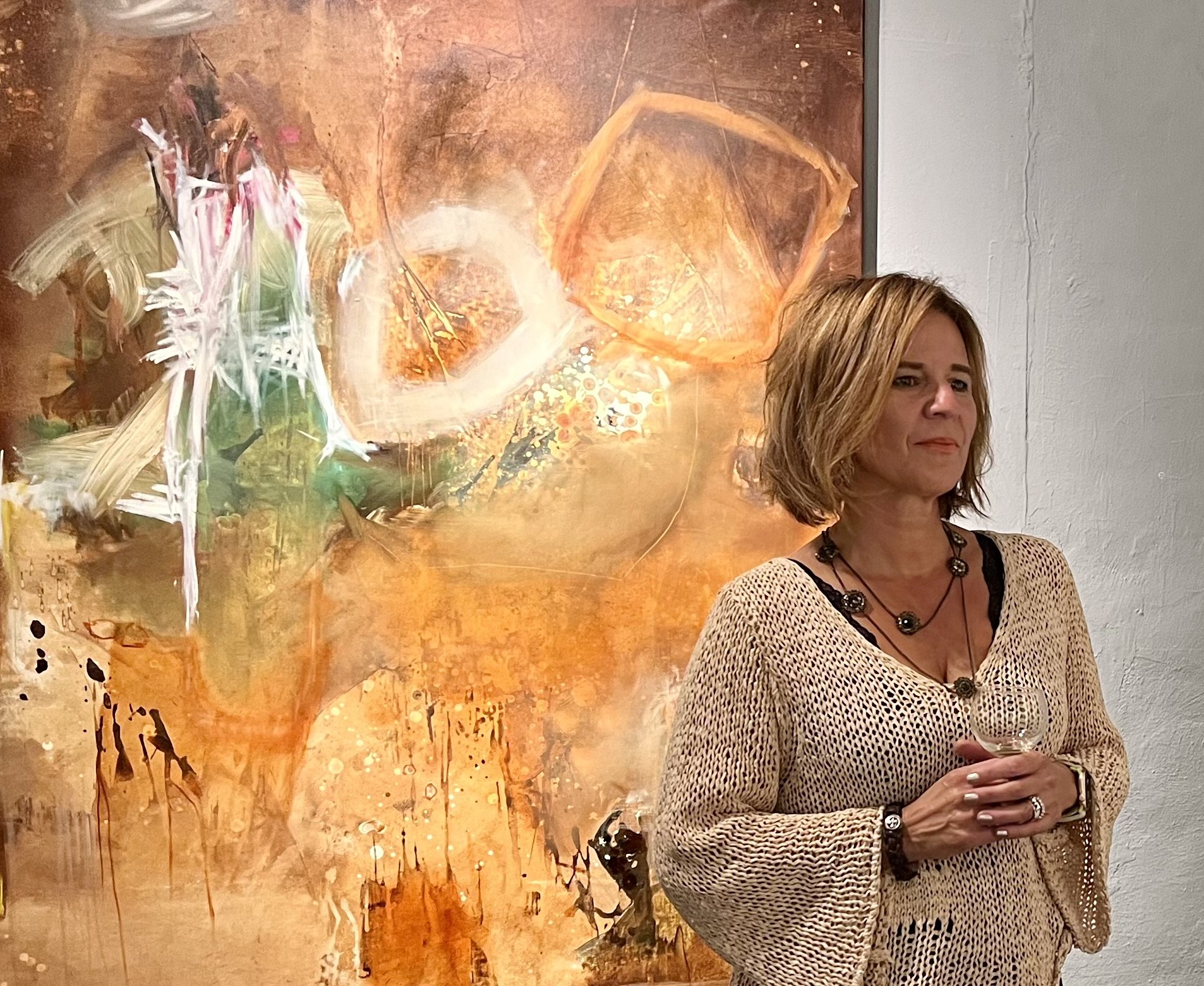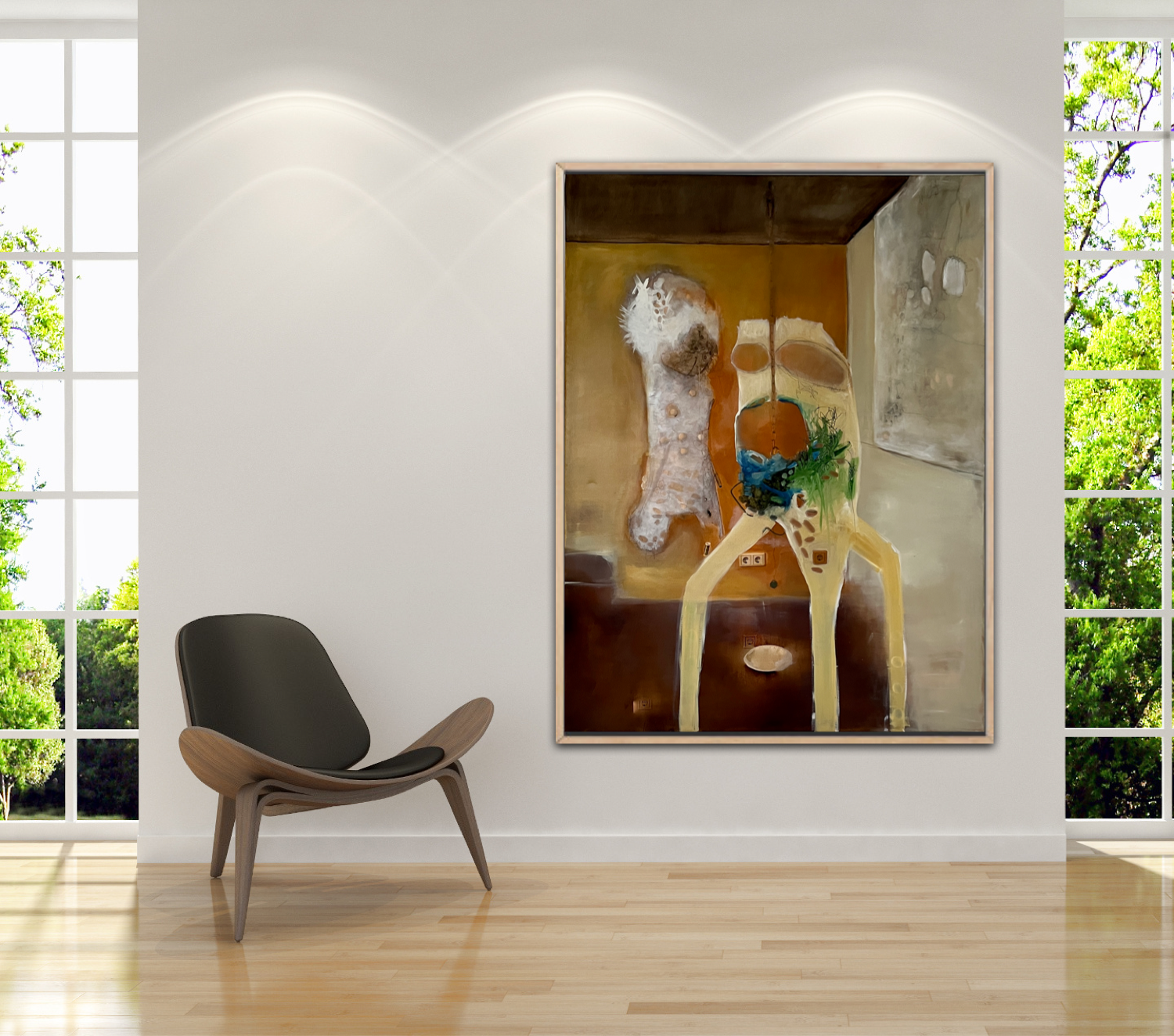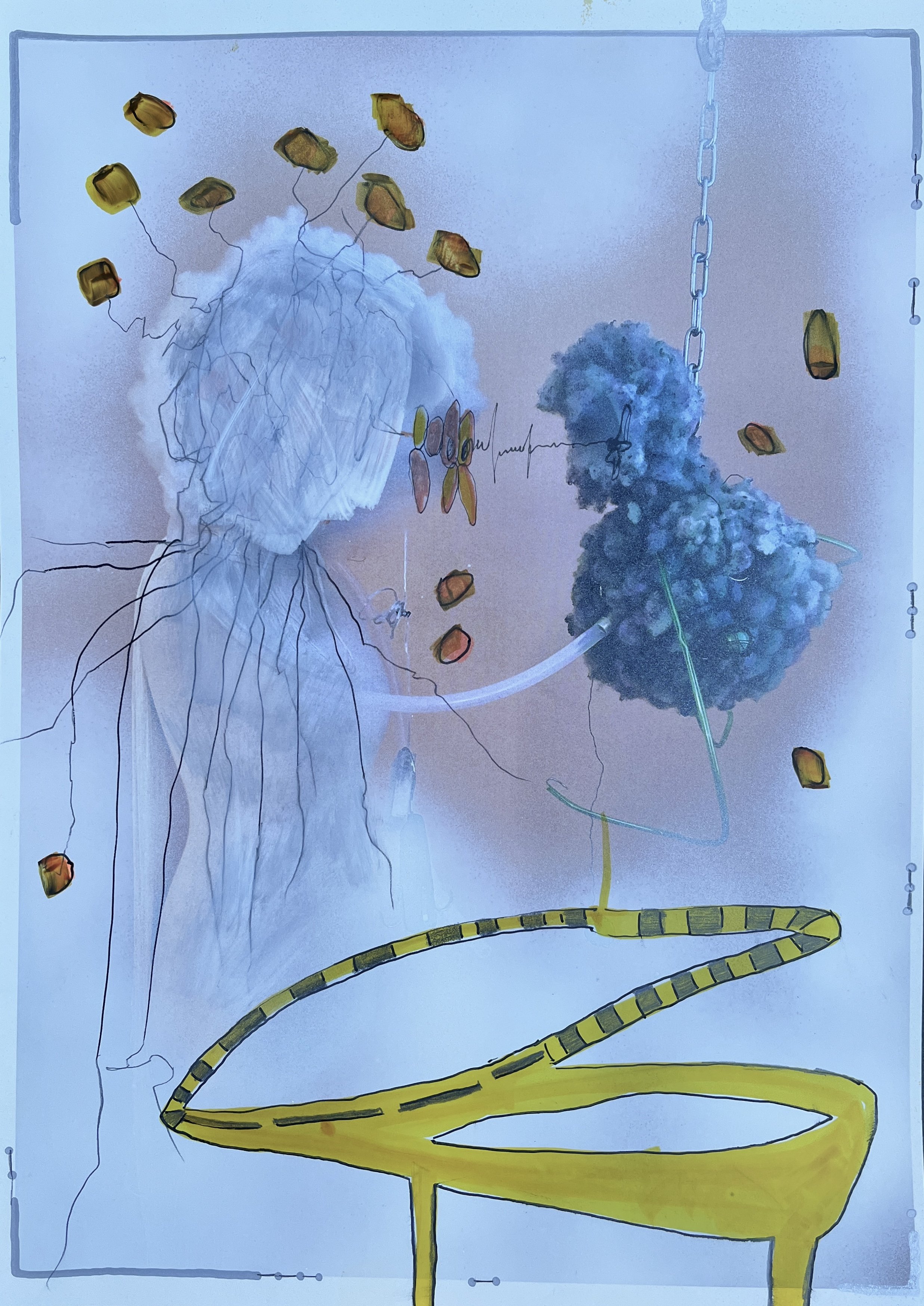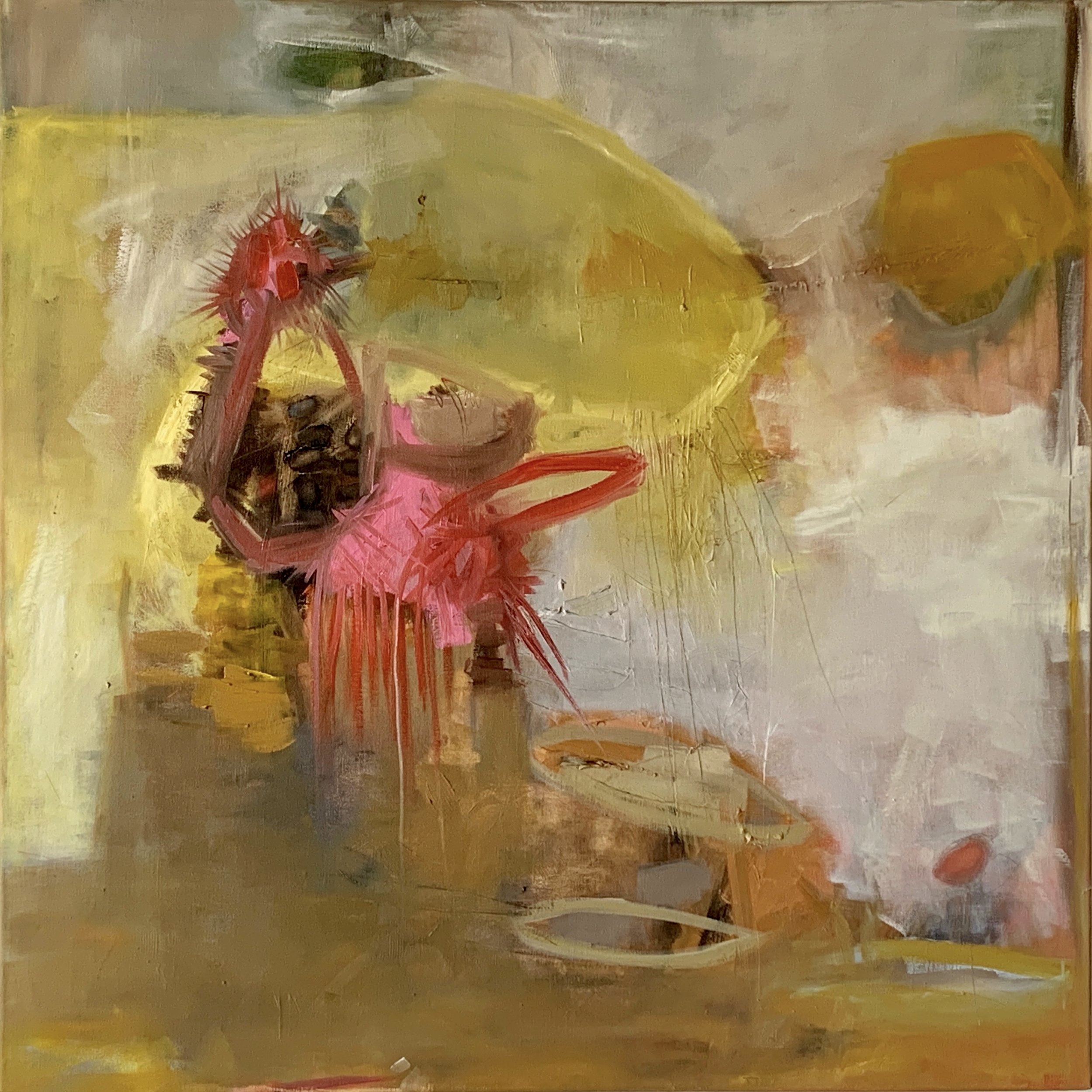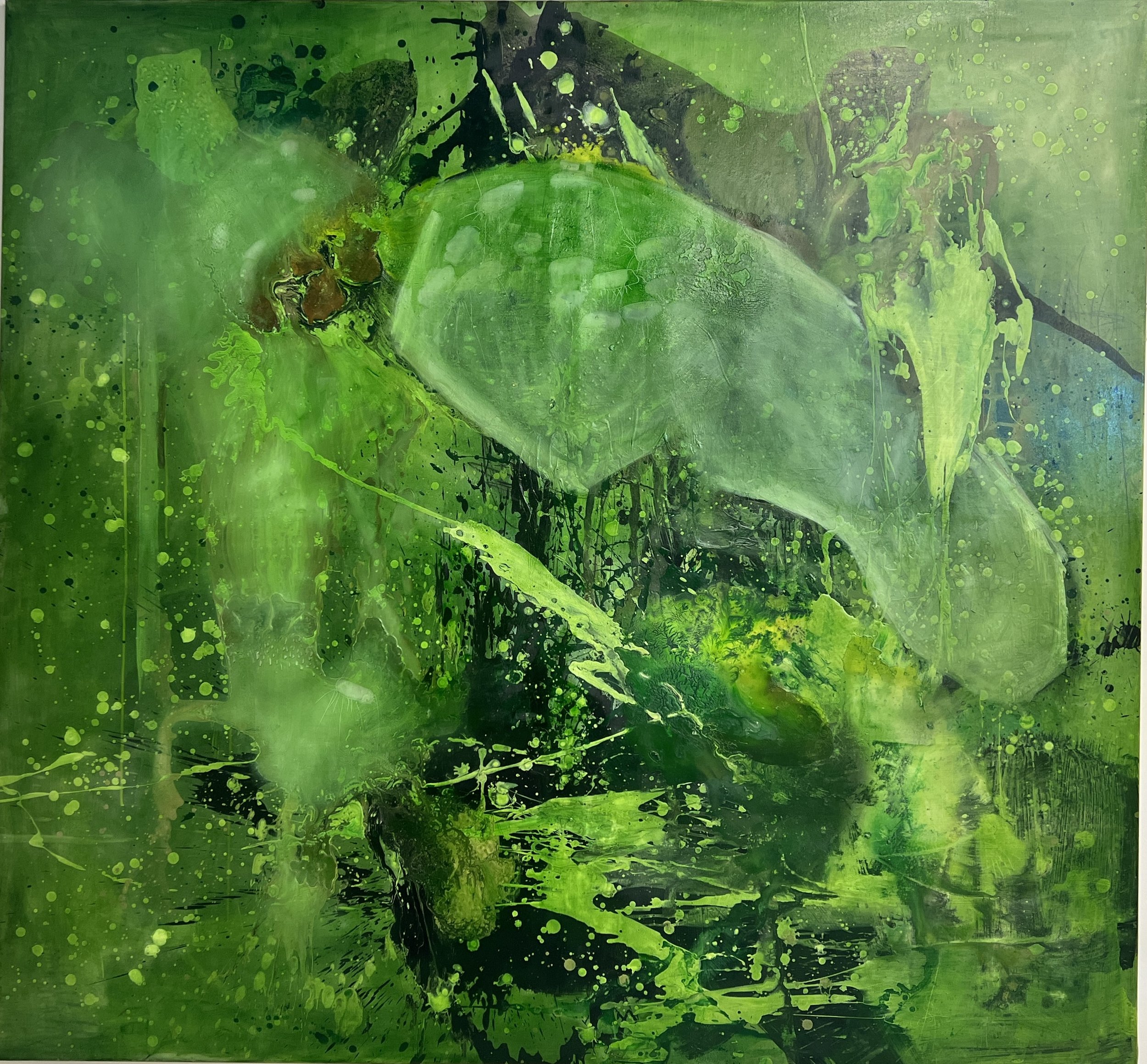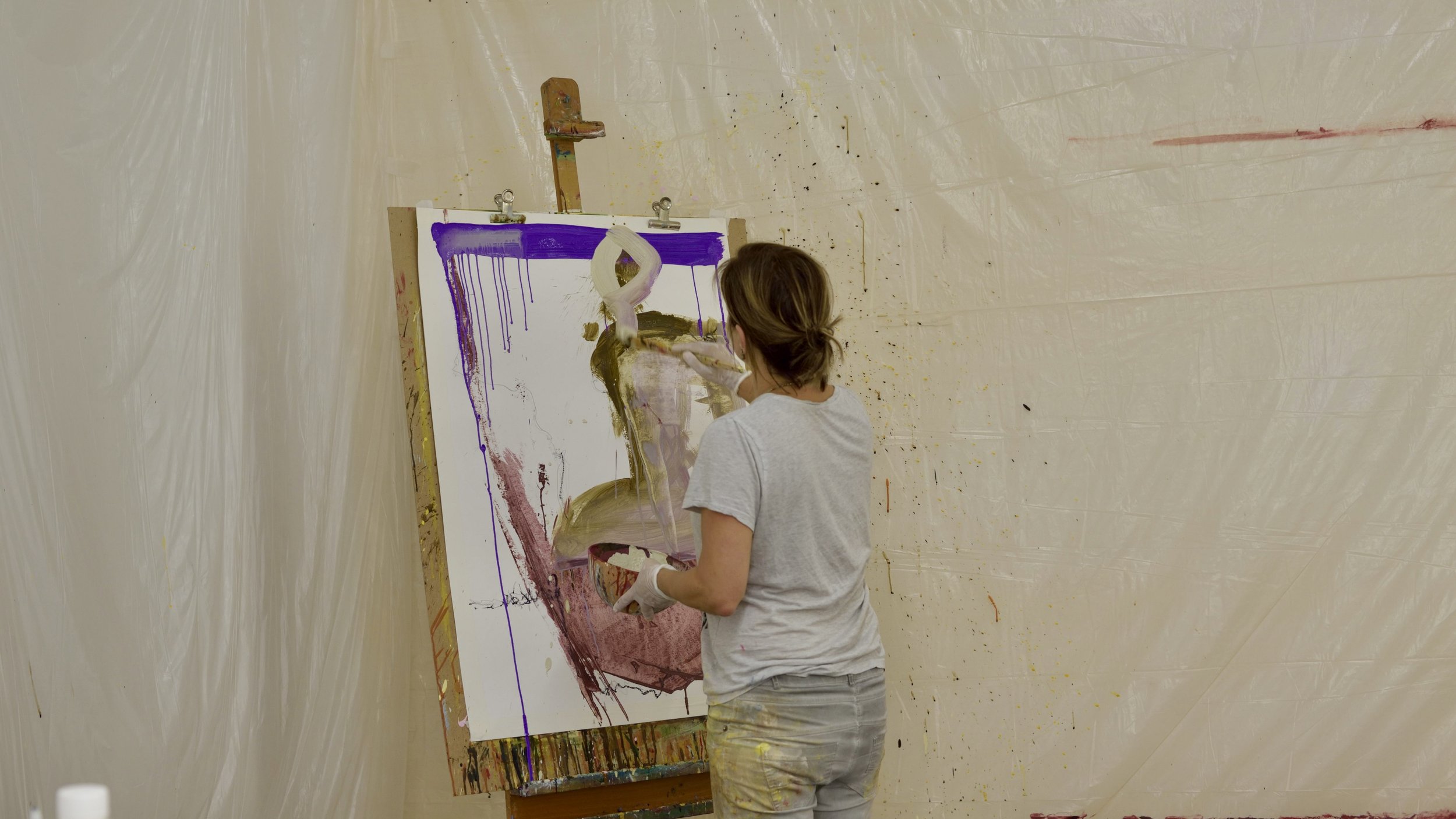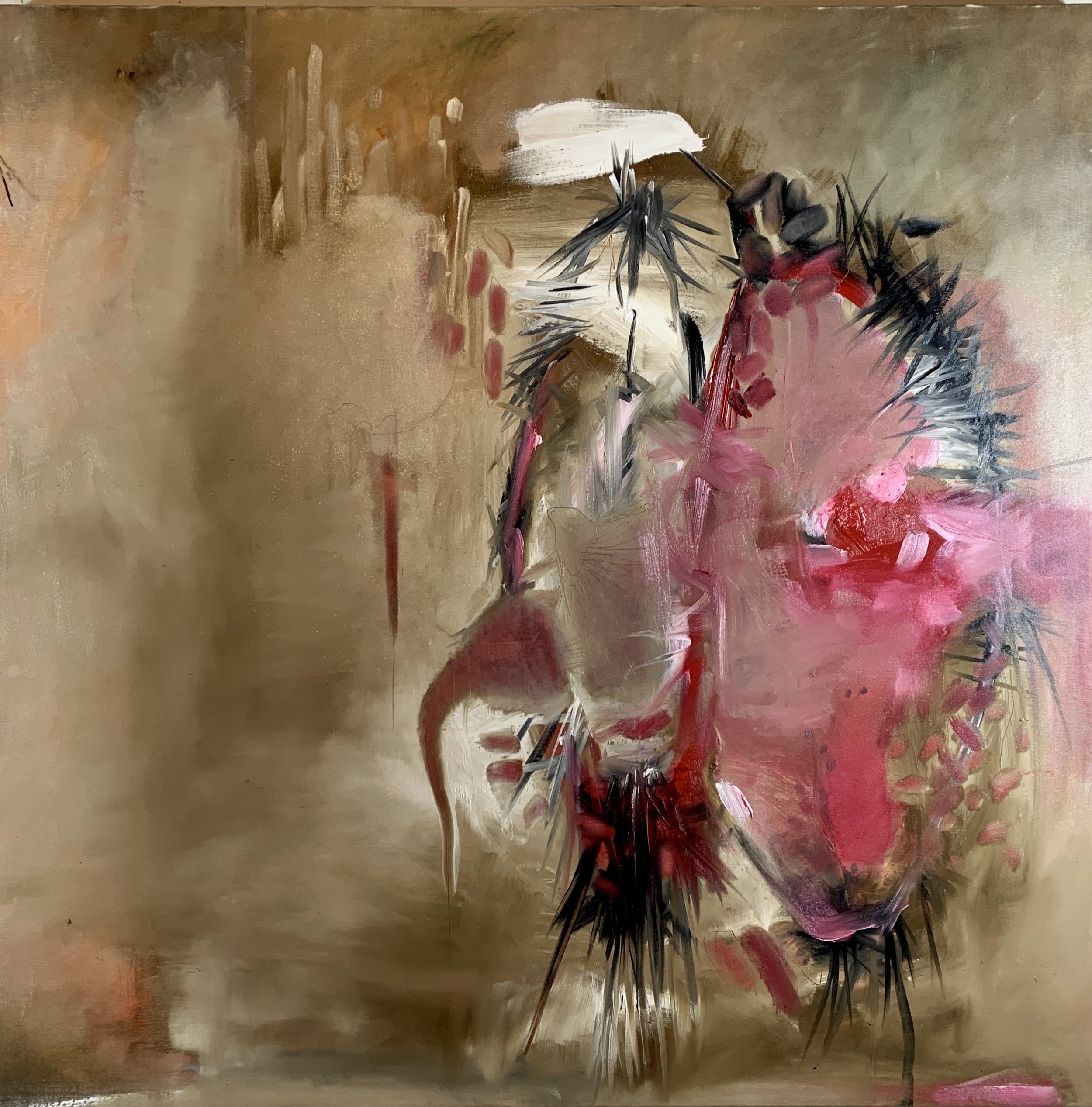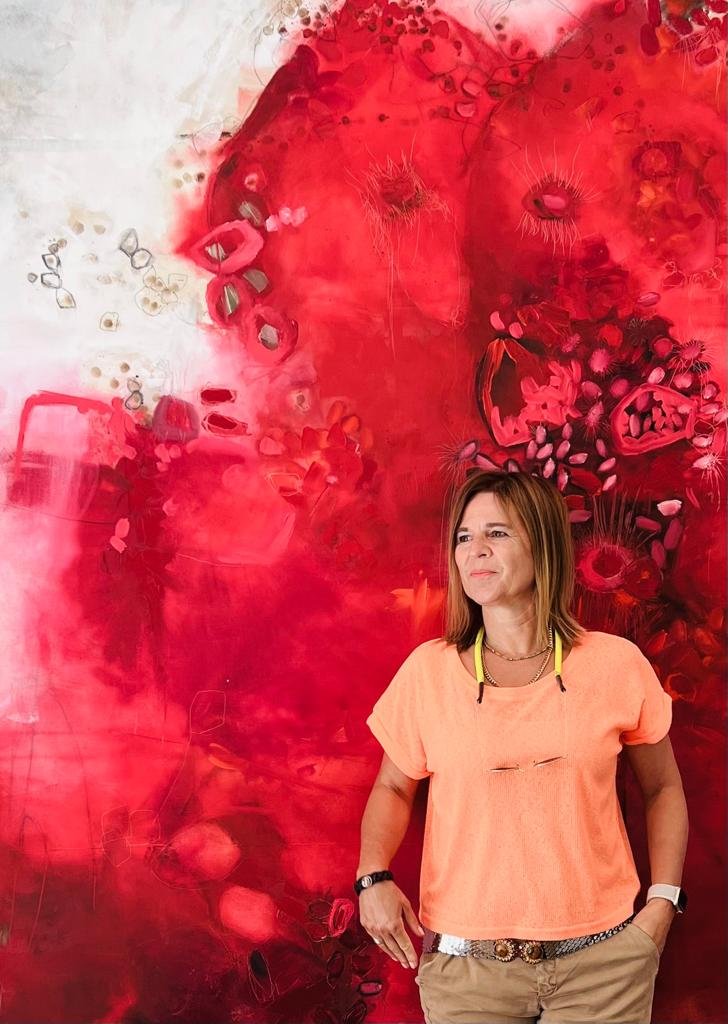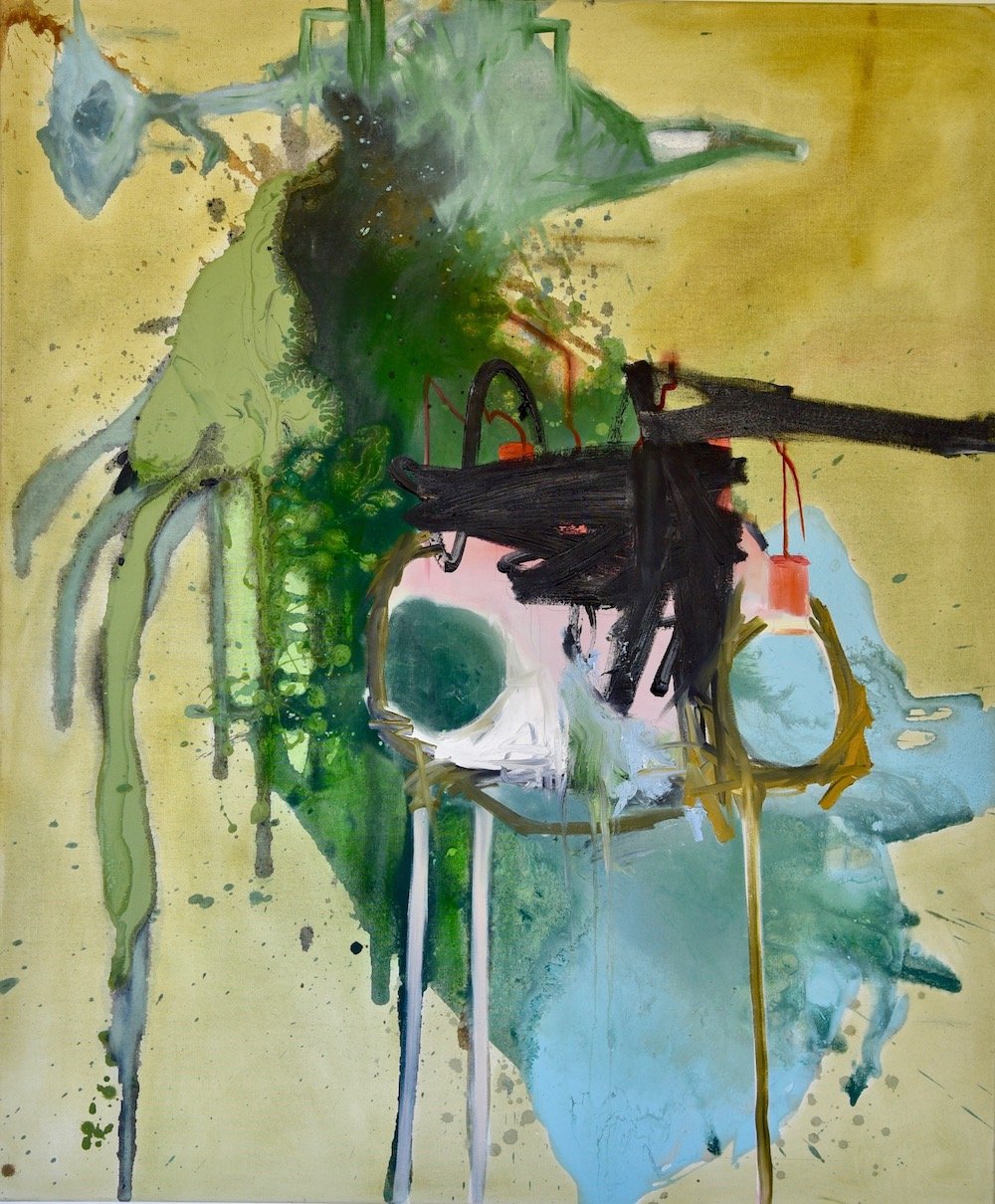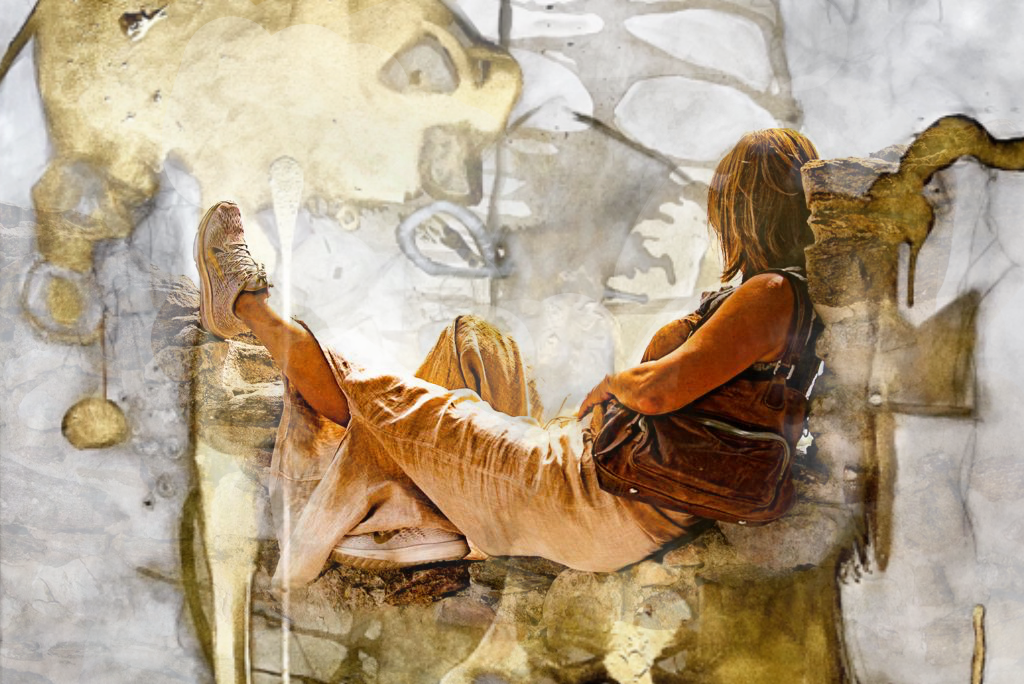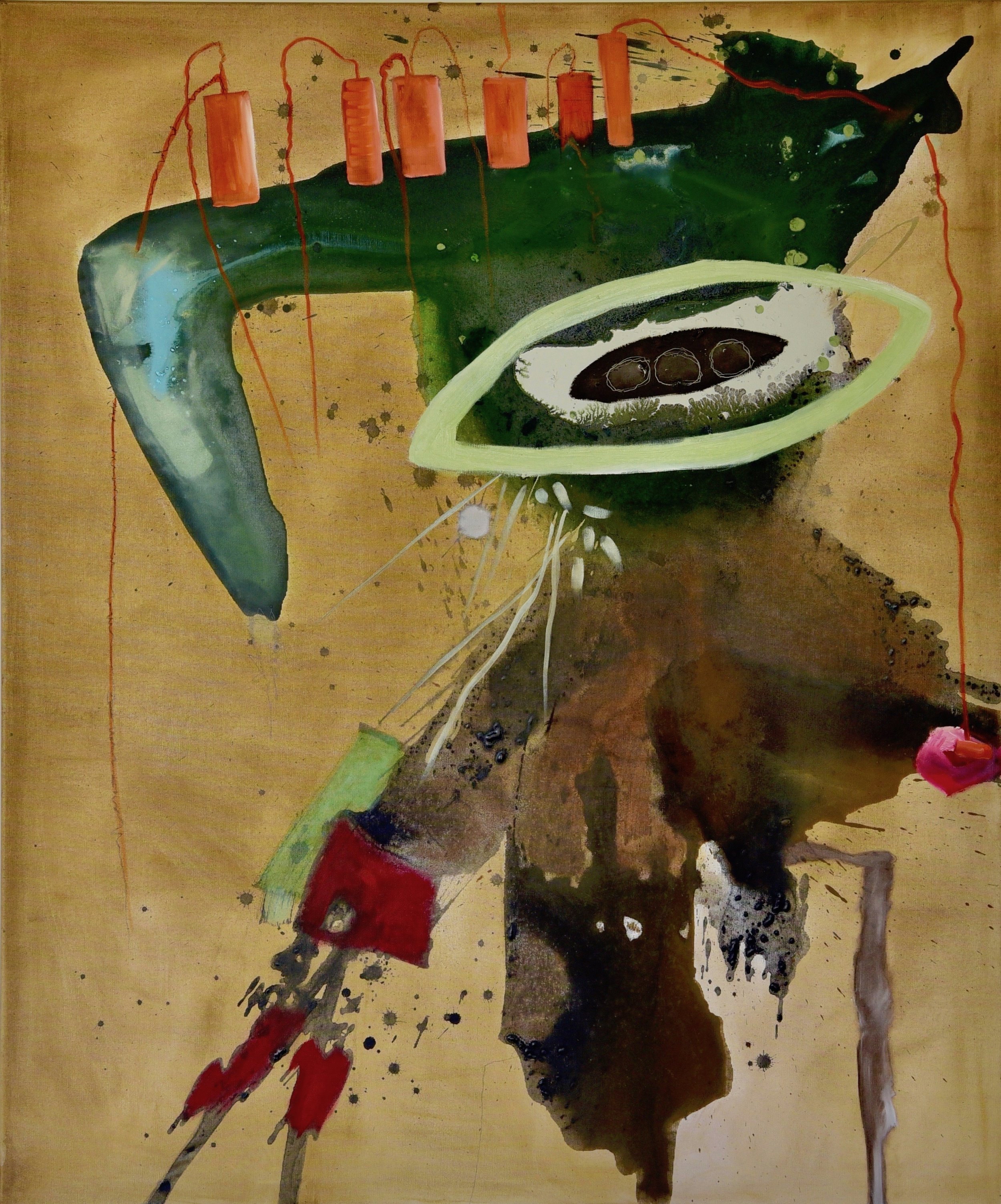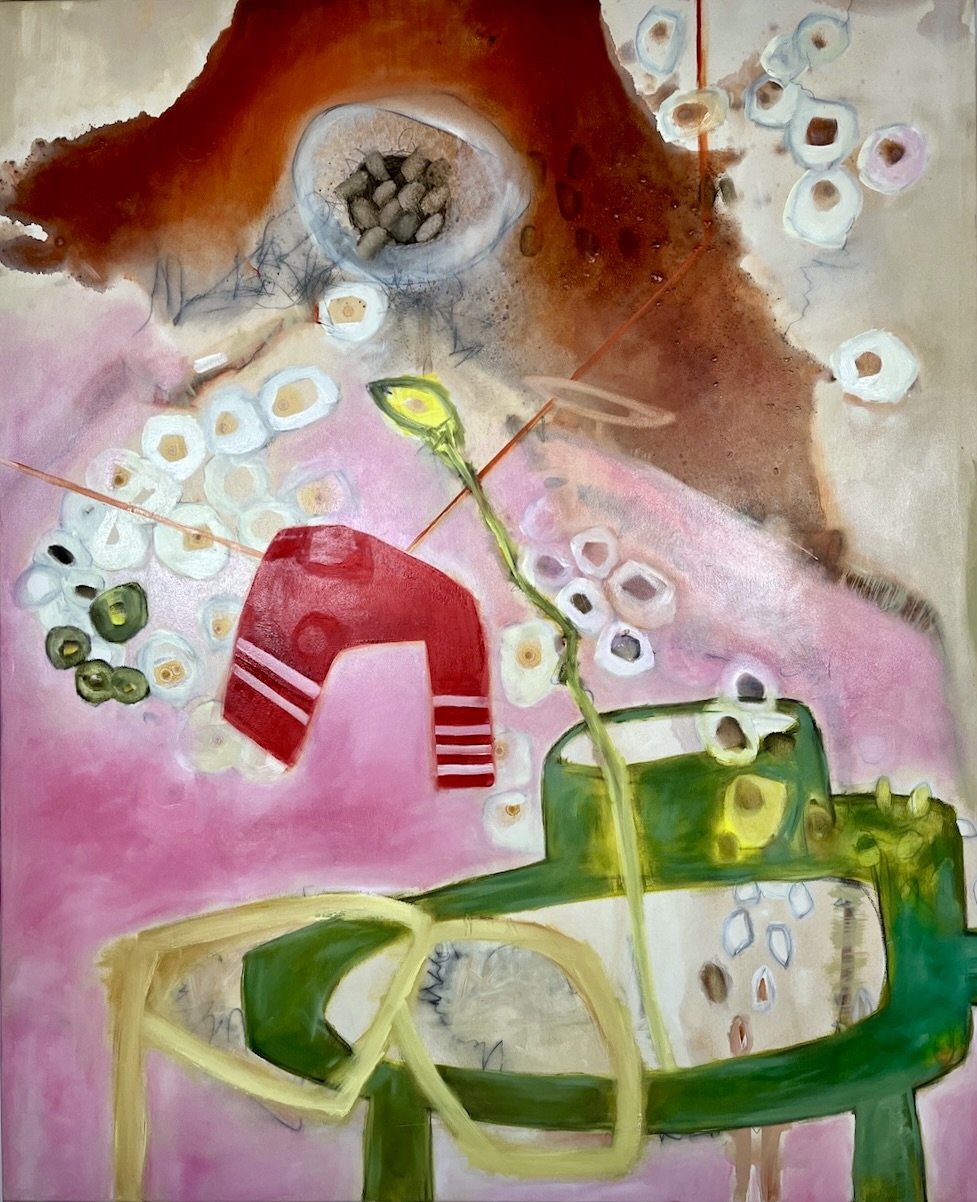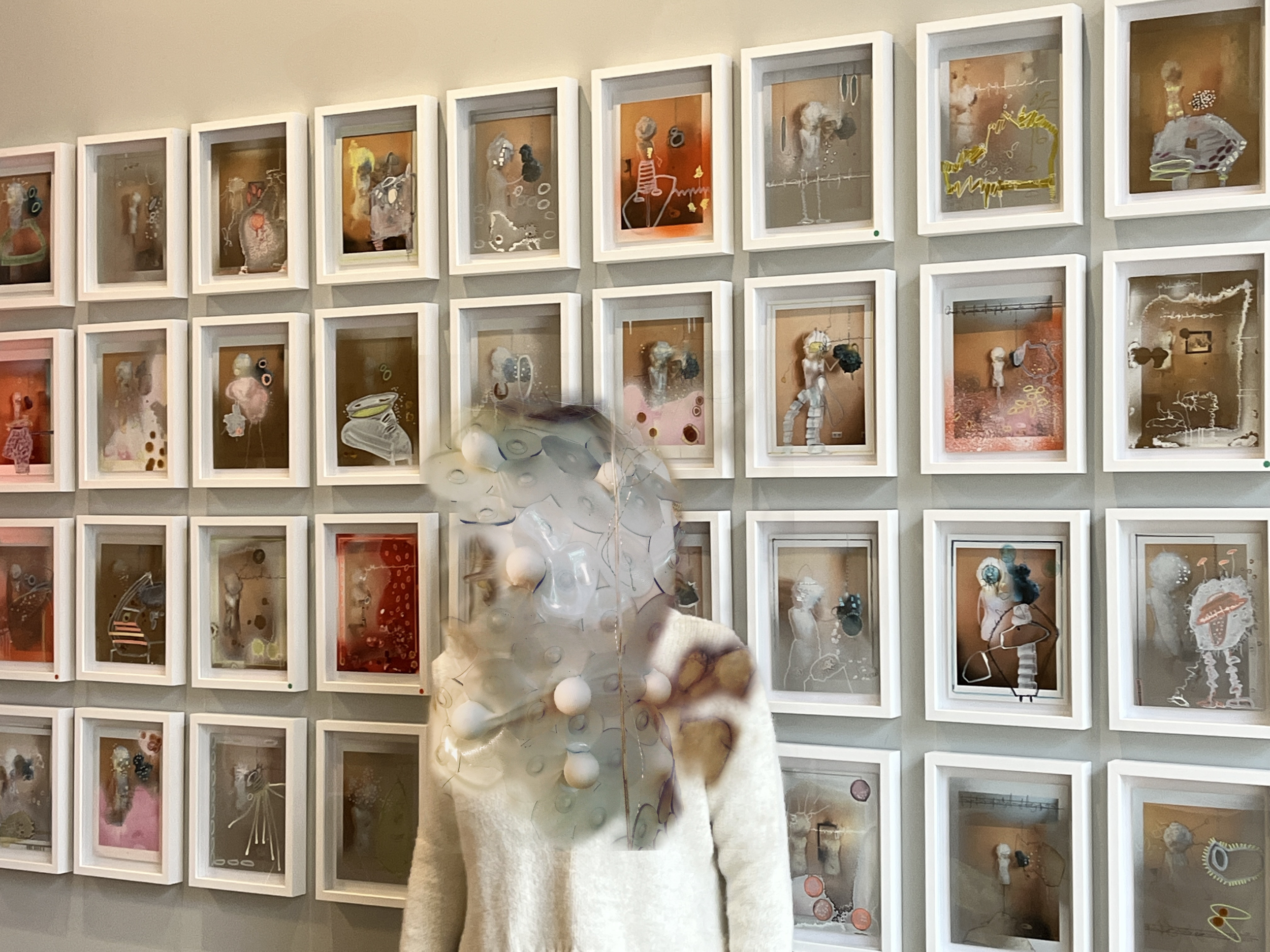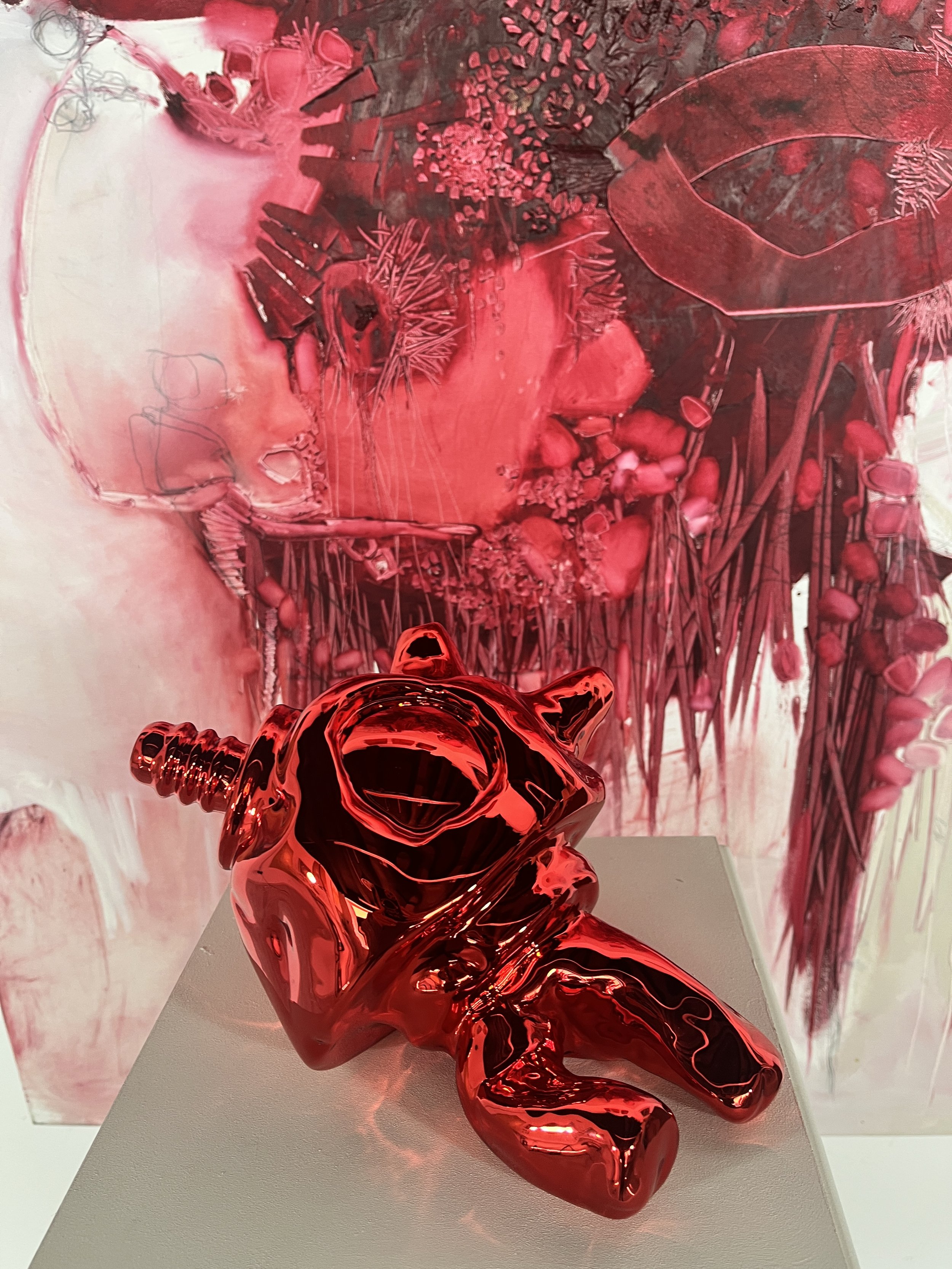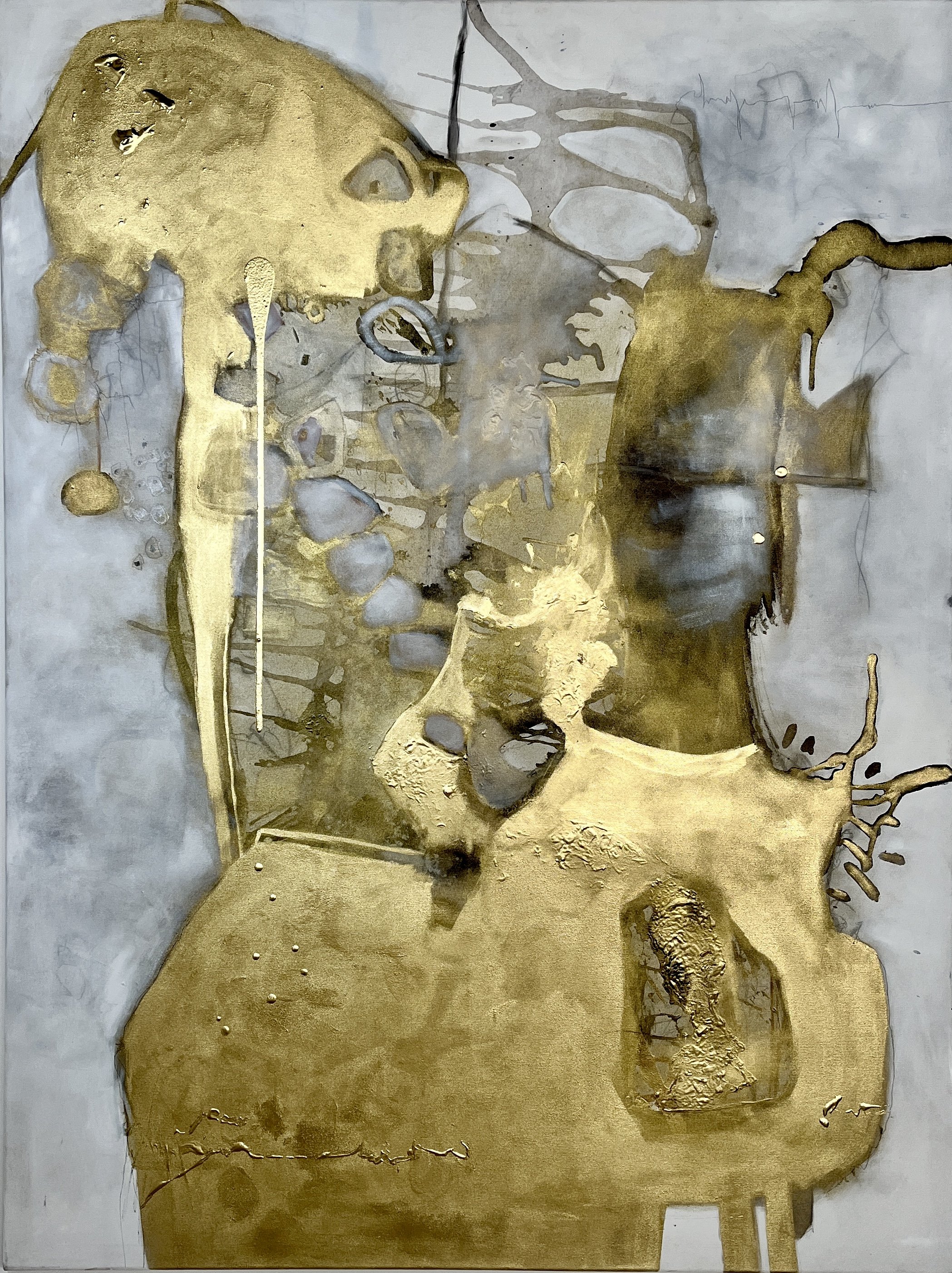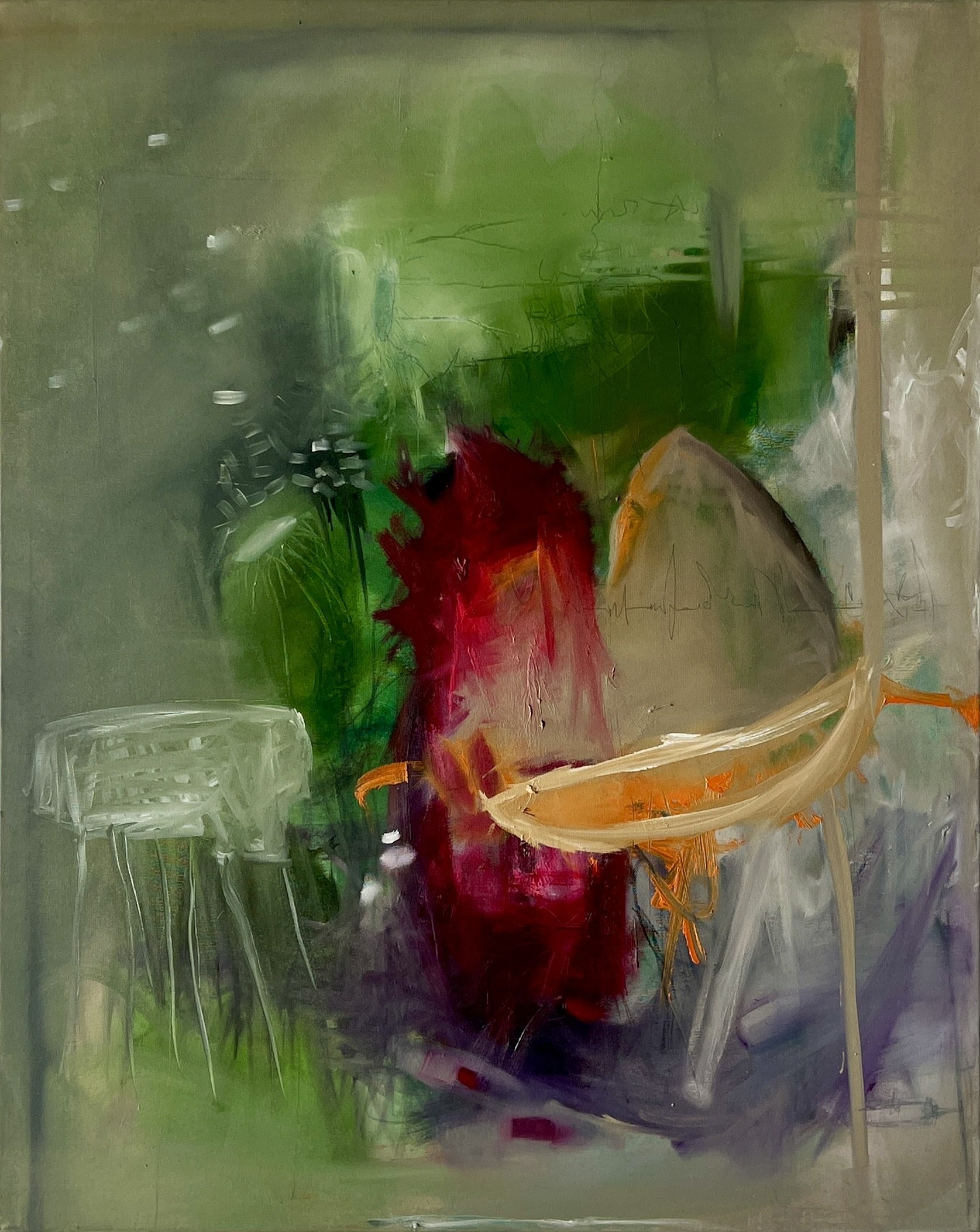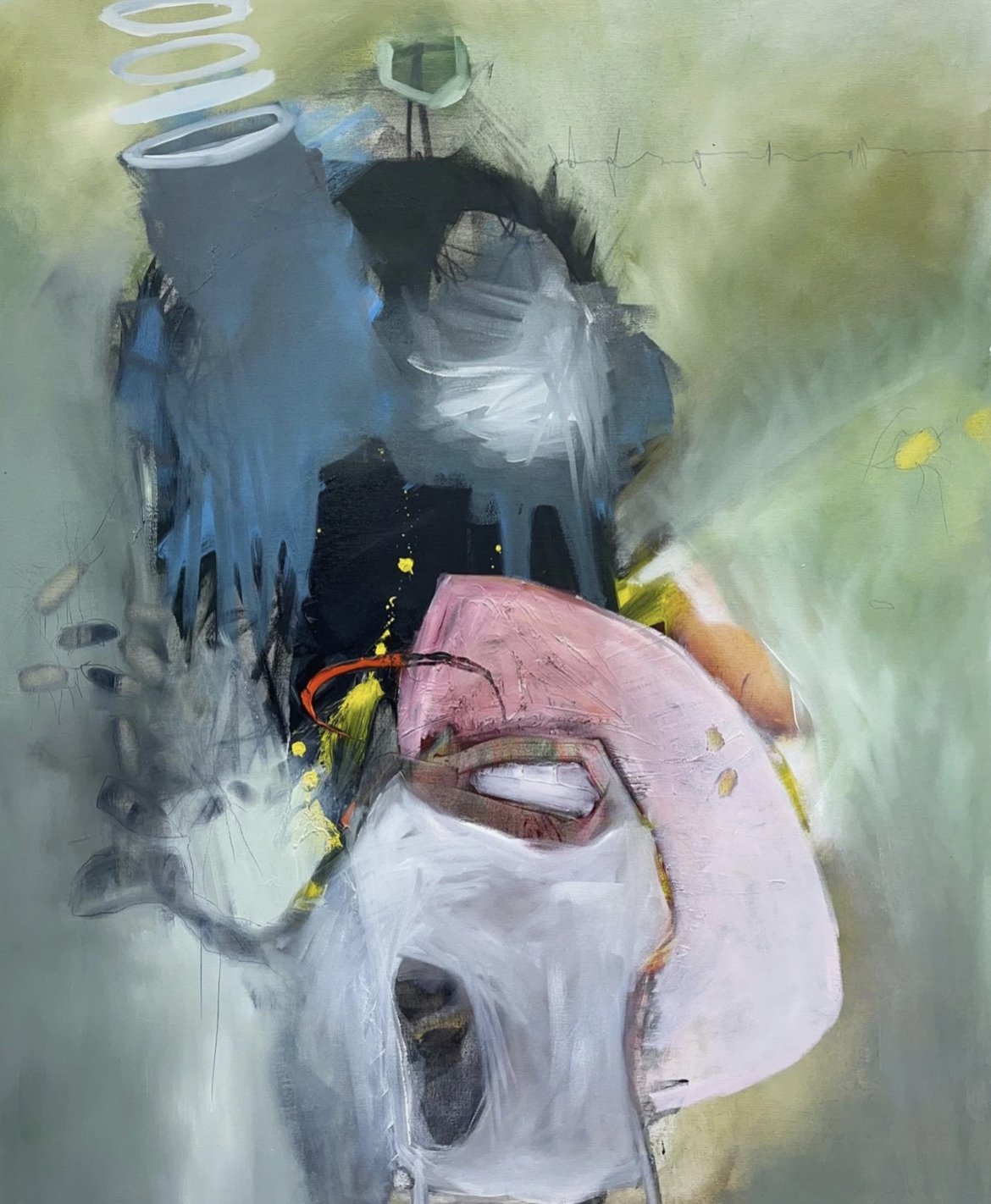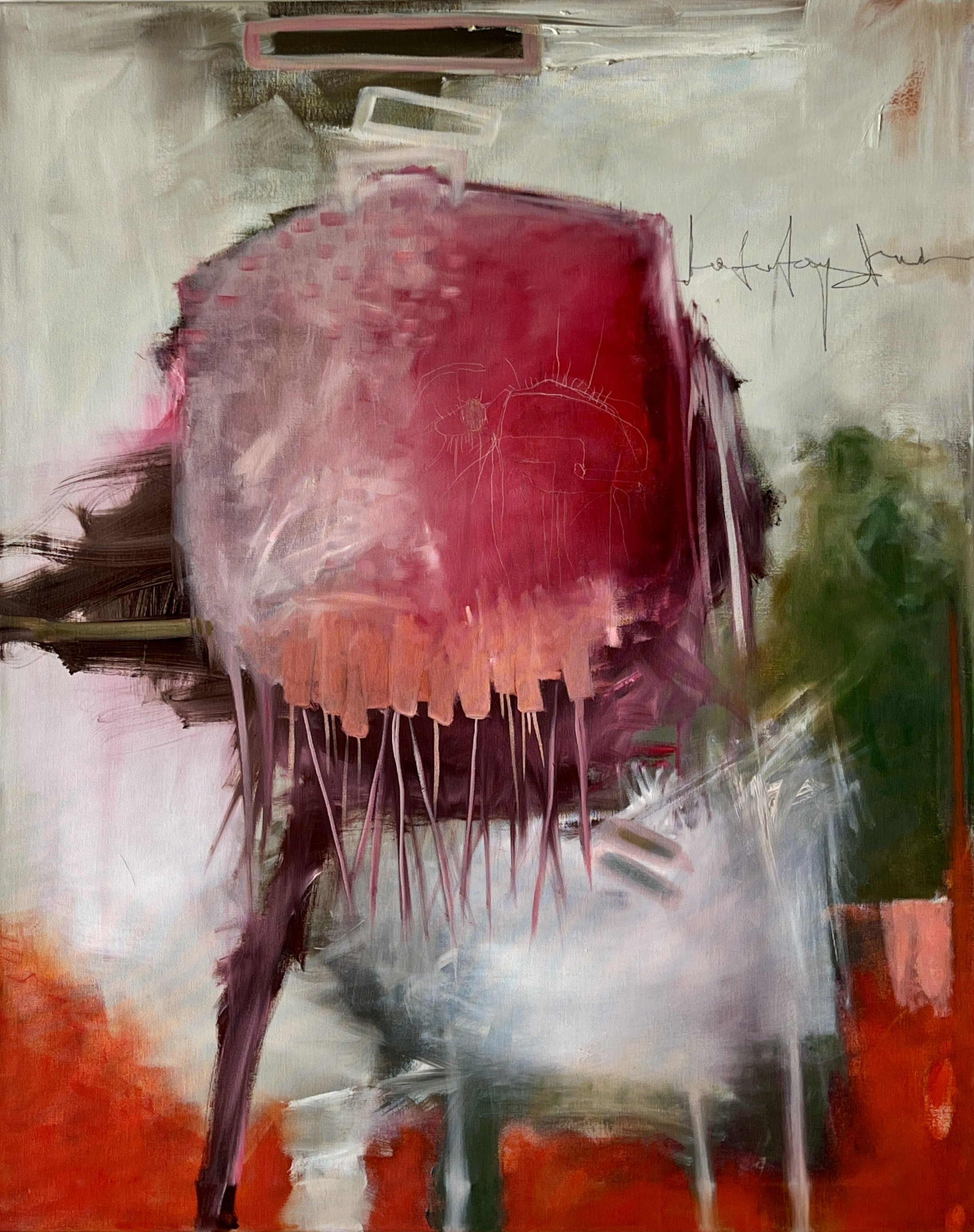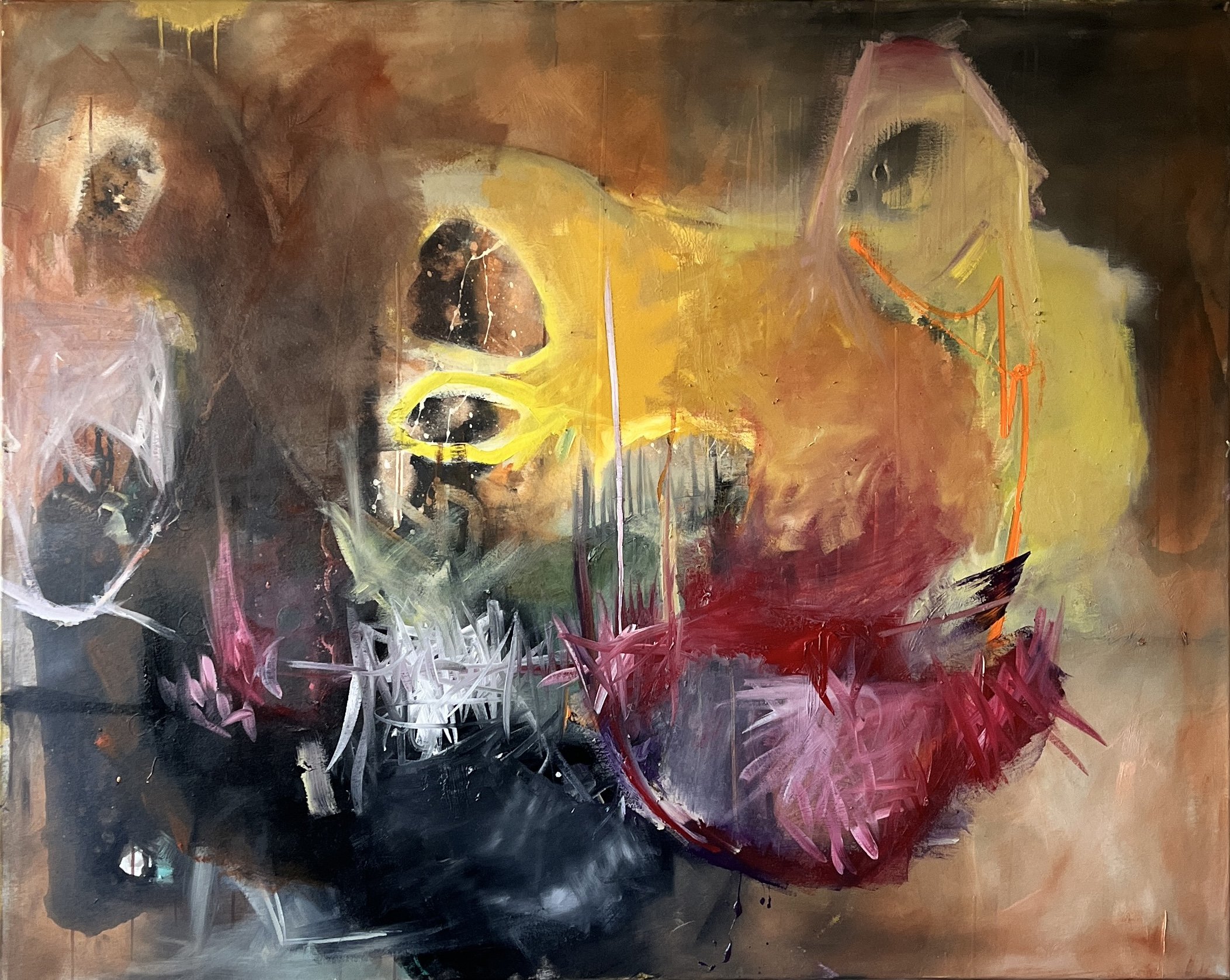Interview
Nicola Barth
Nicola Barth, female painter lives and works in Germany, near Frankfurt am Main. She studied literature and switched from writing to painting 25 years ago until today cryptic dialogues and written language can be found in her paintings. In addition to transformation and permanently metamorphic processes, the focus of her work is the theme of space, accompanied by questions of identity, the alienation and defragmentation of the individual and its location in space and time. Her painting can be understood as a short visual light that gives an insight in a metamorphoric process. Painting, mainly in graphite, acrylic and oil, are complemented by multi-disciplinary art. During the pandemic she has worked with great interest in combining analogue and digital processes. The guiding principle of Nicola Barth's works is transformation. Her endeavor to represent the indeterminable, the changeable in form, shape and space extends to the search for the appropriate language.
In doing so, she does not focus on reality, but always on a behind or in-between and tries to capture fleeting, barely graspable snapshots of development processes. Everything is there at the same time and is allowed to be there equally, the levels interpenetrate, are interwoven. This development, transformation and change of form, in turn, often takes place "invisibly" for the viewer, in spaces and worlds behind, on meta-levels, in spaces that are not actually spaces. "The withdrawal and the emergence, the showing of oneself, the superimposition and disappearance... everything is simultaneously and equally allowed to be there, the levels penetrate each other, are interwoven with each other. This interweaving, transformation and change of form, in turn, often takes place "invisibly" for us, in worlds Behind, transit spaces, on meta-levels, in spaces that are not spaces in the true sense of the word." They are an idea of a dynamic essence of another reality. At the transition of waking and sleeping, in the alpha frequency is a bridge between real events and the dreaming and the entrance to the transit spaces... which are actually none. Her works have been on show in numerous curated individual and group exhibitions in Germany, Italy USA, Switzerland, Athens and 2021 at the London Art Biennale. She has been nominated for various art award an has received the Artfacts Performance Award for Strong Artfacts Rank Growth Trend in 2020.
What is your background and how did you start your journey in the art world?
“When everything is loose and in constant motion, everything reacts with everything else, everything is constantly in process, nothing is really finished and if time and space are only fixed ideas, then deception and change are confusion and chance. This fast pace in nature and our society, as well as the rapid digital progress, require a stop, a standstill, and a retreat. My analogue response to this is painting. Because my words are not enough. I studied literature and theatre, film and television, and psychology and at some point, I wanted to write myself. That’s what I did in the beginning: poetry, short prose, book reviews, articles for daily newspapers and literary magazines. Gaining knowledge is what drives me. I’m curious and inquisitive and want to see what’s behind the curtain, under the surface of the water, above the clouds. I gave birth to two children and the existential questions that move us all became increasingly clear. How would I explain to my children who we are? Who am I? Where do we come from? Where are we going? Why are we here? What is our purpose? I had to put down my pen and pick up a paintbrush because what I wanted to understand and explain was so complex that I couldn’t put it into words. We can’t finish thinking about the world. It cannot be grasped by the mind. Language is usually unambiguous, controlled by the mind, and elevates us to a conformist level. Painting, on the other hand, deviates from the norm. It leads from the depths into the depths of an experience of being. It is a more open form of communication that is grasped with other senses and allows more latitude and freedom. Here it is about experiencing and not understanding.
In non-objective painting, I can show a part of what I don’t understand but want to understand. I don’t know what I paint, but I see it as a small subjective excerpt of a large overall process that is constantly in morphological change, and I take the freedom to make an excerpt. Therefore, the triad names of my paintings like ‘HONO BADI NISS’ and ‘DULUSCH ET IGANI’ are more to be understood as sound or frequency and are meant to point to the inner idea of things. There is indeed a world behind this world. And it is constantly in motion. As a philosopher without words, I try to make frosted glass permeable.”
What inspires you?
“Nearly everything and everyone. Maybe it's a bit like this: the artist has the ability to wander through the world without any connection to reality to lose, and he can bring something from “there.” However, this is subject to different legal regulations “from then on.” Almost anything and everyone can be an inspiration for me, be it conversations, books, nature, special materials, spaces and rooms. And of course, I accompany other artists in their exhibitions and studios and follow their work on Instagram. So, I am influenced by everything and everyone and always. For me, the most important question is: under what conditions are we ready for inspiration? In my experience, inspiration always comes spontaneously and unexpectedly. Often when I do everyday tasks. I think a man just has to be open and relaxed when looking for inspiration; I call it “on air in off space.” Inspiration itself can not be forced, but the circumstances under which inspiration takes place can be influenced. Certain synapses in the brain have to be connected to each other, which is an involuntary process. It's always about input and output and the individual “in between,” which manifests itself in an artistic result. For me, a picture, a sculpture or even music is a living thing - An organism that grows out of itself.”
What themes do you pursue? Is there an underlying message in your work?
“There is one major theme that runs through all of my work and that is the morphology, the transformation. The idea that there is something behind everything - there is very much a living thing that I want to show. This development, transformation and change of form in turn takes place for often “invisible” to us instead, in spaces and worlds behind it, on meta-levels, in Spaces that are not in the true sense. And then there could be one form of communication, speech and written language, that is entirely different from anything we know. What are you hoping to communicate to the viewer through your work? I would say: The main thing is added value. That can be a smile, an ‘AHA!’ experience, a self-awareness, a new unknown perspective... I want to lure the viewers of my painting into new spaces of experience to leave an impression. Art is ultimately experience and self-knowledge - for the artist himself as well as for those who deal with the work. I think I have the possibility as a creator of art to invite my fellow human beings to come along and to get out of this norm-bound thinking. I invite people to follow me into other spaces.
If what I have created is good, then I have created a new kind of imaginary space of experience for the viewer in which he can move and experience himself in a special way. And then I have created an added value. Of course, I would like to achieve this as often as possible. But I am also concerned with the above-mentioned capture of a permanent metamorphosis. I see my images as an arbitrary frozen still image of something that is in a permanent morphic process. Everything is constantly in motion, nothing remains. Time and space are in question. This can sometimes make you dizzy. I paint against the dizziness because ‘being one with’ is a way to resist the chaos. A moment of mindfulness that I want to keep for myself and reveal to others. This fast pace in our society and the rapid digital progress demands a stop, a standstill, a contemplation to get behind. I would be happy if I could show society an idea of the complexity and liveliness of the world and my pictures remind the viewer of this. This does not have to be done cognitively, one can also gain truth or knowledge through an experience - the world is not one-dimensional, but multi-dimensional, it is multi-layered, rich in variety, alive and simply fantastic! There is not always only one right and one wrong - there are many variants, much in between, that also have a right to exist as it is - this applies equally to people, things and concepts/ideas. We are all on a journey and develop constantly and steadily and for everything and every one here there are different time tempos, we should take that into account and be much more gracious with each other.”
“There is one major theme that runs through all of my work and that is the morphology, the transformation.”
How would you describe your work?
“If I had to describe my art in three words I would say it is abstract - metaphysical - metamorphic, but whether that is the case is for others to judge. In any case, it is also multidisciplinary - even though painting is my home base, I always allow myself excursions into digital photography and sculpture when the subject requires it. My work is abstract because I don't aim to represent easily identifiable objects or scenes. Instead, I invite viewers to interpret and connect with my art on a personal level, allowing them to find their own meanings within the abstract forms and colours. I also aim to create a sense of otherworldliness in my paintings. I want viewers to feel as though they've stepped into a dreamscape where the boundaries of reality blur. It's metaphysical because my art often delves into profound questions about existence, identity, and the interconnectedness of all things. I use abstract forms and colours to explore the intangible aspects of life. My art is metamorphic, which means it's all about change and transformation. When you look at my paintings, you might notice that they don't stay the same. It's like they're constantly evolving, just like life itself. In essence, my art represents a quest for the sublime, an invitation to contemplate the mysteries that lie beyond the surface of our everyday lives. It's a visual exploration of the unseen and the unknowable, inviting viewers to join me on a journey of wonder and curiosity.”
Which artists influence you most?
“Surely, there would be some names of great artists whose works I think are great for various reasons that have inspired and influenced me on a formal level. Especially those I learnt directly from, Markus Lüpertz and Peter Casagrande, for example. Then there are the great painters whose work I love, such as Emil Schumacher, Antonie Tapes, Albert Oehlen. Artists like Eva Hesse, William Kentridge, Jonas Burgert - I don't really like naming names because then not everyone is included and there are so many great artists in my immediate working environment. But as an artist you are also always a ´seismograph of society´ and ´tentacles´ quite openly porous through the world. The artistic work is ultimately about input and output and the individual 'in-between' that manifests itself in an artistic result. So, I am influenced by everything and everyone and always. People, conversations, nature, materials, spaces, texts - everything can inspire me if I am ´open.´ The idea of transformation: “What can you make of it?” is always there.”
What is your creative process like?
“I am primarily a contemporary- and abstract painter, this is my homebase but regularly allow myself excursions into photography and three-dimensional work sculpture/installation when the subject to be worked on requires it. For example, a photograph, which is usually a determination of time and place, gives me the possibility of links between places and objects from different times through digital processing; blending/retouching. Also, the possibility of constructing and deconstructing spaces and creating virtual spaces and realities.
In painting, I do what others do. I work with pens, brushes, fingers and everything you can dip in paint on canvas and paper. But this happens according to very individual subjective criteria - as a painter you constantly have to make decisions - which colour? Which brush? Which stroke to use, to discard, to paint over, to take out, to overlay? This is a subjective choice of means and each time a very individual decision. The multitude of decisions made within the creation of a painting - sometimes intuitive, sometimes deliberate - make it distinctive and also unrepeatable. Unique expression of a period of time in which an artist devotes himself to a work. It is always about input and output and the individual „in-between“ that manifests itself in an artistic result. To my mind, an image or a sculpture or even music is a living organism that grows out of itself accompanied by the hand of the visual artist. In that sense, I'm not doing anything special, I'm just doing my thing. And I try to do it as authentically, presently, unadulteratedly and well as I can.
Accordingly, my painting has also been a development, so it is not only a matter of development processes in terms of content, but also formally my painting has developed further, it has become more multi-layered over the years. In the origin I am a painter, these are my roots and there I always move back again and again. But as soon as the given frame gets narrow I have to leave and move three dimensionally in space. Then I make sculptures, photograph them, edit the photos digitally and bring them back into a two-dimensional plane. It´s like a trip. I always want to try something new, if I know how a picture or a technique “works” then it get´s boring for me. After all, I want to develop further. This does not mean that don´t take into account everything I´ve learned. Certain well-functioning techniques are incorporated into new work. These excursions away from the canvas always end up feeding back into my work. For example, fort wo years I created unique pieces of fashion with four other creative women. That was a great experience, a bubbling kitchen of ideas and the preoccupation with fabrics, leather, skins does not let me go today and is always found in rudiments, either in my sculptures, or in sewn papers. Many of my works have to do with transformation also in the process of creation, but that is also logical and conclusive for me, because that's what I'm all about in terms of content.”
What is an artist’s role in society and how do you see that evolving?
“Art can do many things, but it seems most important to me that this universal language can connect people and cultures and serve as an instrument of international understanding. How I think it will develop? Artists are often pioneers in the exploration of new techniques, materials and forms of artistic expression. They help to expand the boundaries of art and develop innovative approaches. I think in the future there will be more interdisciplinary and collective work. The separation will be abolished in many areas.”
Have you had any noteworthy exhibitions you'd like to share?
“SPACETIME METAMORPHOSIS (Wiesbaden) and ALPHAFREQUENZEN (Hamburg) both 2022 in collaboration with the INCUBARTOR of Galerie Rother Wiesbaden - two multidisciplinary solo exhibitions in which I was able to present my themes of transformation processes and shape-shifting not only in terms of content but also formally within the exhibition. There was my painting, moving images, digital photography, video and my 60-piece work Raumzeitmetamorphosen, which gave the first exhibition in Wiesbaden its name. The 60 images from the 1st to 3rd spacetime represent 60 seconds, i.e. one minute in a variant space 60 variants of a situation, 60 variants of an abstract dialogue - 60 variants into which an initial situation can be transformed. Anarbitrarily determined time dimension to make the diversity of variants comprehensible to us - because the ides that time and space are only fixed ideas makes u dizzy. The SPACETIME METAMORPHOSIS have neither order nor ranking. They are in a state of suspension and they all stand next to each other on an equal footing and at the same time. I am not interested in beauty and perfection, but in pointing out the ides of a dynamic essence of another reality and its abundance of variations and possibilities for us. I am looking forward to being in South Korea in March 2024 at the CICA Museum with this topic.”

